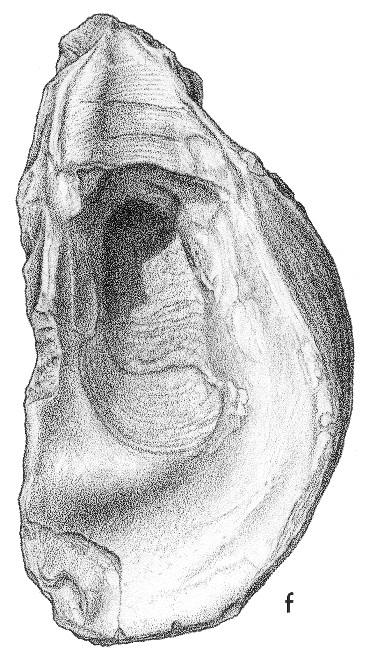
Revised descriptions of New Zealand Cenozoic Mollusca from Beu and Maxwell (1990)

 | Revised descriptions of New Zealand Cenozoic Mollusca from Beu and Maxwell (1990) | 
|
  (Pl. 32f): plaster cast of holotype (original in Naturhistorisches Museum, Vienna), "Wanganui River", almost certainly from the Crassostrea reef in Wilkies Shellbed, Mangapanian (TM4280, GNS) |
Beu & Maxwell (1990): Chapter 14; p. 280; pl. 32 f.
Synonymy: Ostrea ingens Zittel 1864, p. 54
Classification: Ostreidae: Crassostreinae
Description: Exceedingly large (200 mm to more than 300 mm high), exceedingly thick and heavy, calcitic; exterior irregularly foliose, without true radial or commarginal sculpture; cemented to hard substrates by umbonal area of left valve. Some specimens oval (length up to 0.7 height) but most narrowly elongate, length half height or less, and relatively deeply dished. Left valve exceedingly thick, deep (inflation of left valve 60-80 mm or more; interior cavity 30-40 mm or more deep), most specimens curved weakly to left over ventral half; ligamental area large, in most specimens elongate (a little higher than wide), depressed medially and with a margining groove and ridge up each side; no sign of chomata in any adult specimens. Adductor scar at centre of cavity height, a little in front of centre, gently to steeply inclined (dorsal side depressed), dorsal margin straight to slightly irregular, ventral margin deeply convex, i.e., a rounded semicircular outline; retaining bright purplish red colour in most Pliocene specimens. Ventral area of internal cavity with a wide shallow groove in most specimens, extending from posterior of adductor scar to antero-ventral extremity of shell. Right valve almost flat, more weakly foliose than left, about 15 to 40 mm thick (i.e., considerably thinner than corresponding left valve); hinge a mirror image of left one; adductor scar as in left valve but less steeply inclined.
Comparison: The youngest specimens of Crassostrea ingens (early Nukumaruan) occur in the base of Hautawa Shellbed at Hautawa Road, north of Hunterville, Rangitikei valley, and in the base of Pukenui Limestone in southern Wairarapa. The oldest specimens referred here (tentatively) are relatively small (to c. 150 mm long), narrow, laterally compressed specimens from the basal grit member of the Hurupi Formation in Putangirua Stream, eastern Palliser Bay (early Tongaporutuan); we are not aware of any Kapitean records. Rare, poorly preserved ?Crassostrea specimens in Castlecliffian mudstone at Ohiwa Harbour, Whakatane (in NMNZ) appear to belong in a smaller species with a wider ligamental area than C. ingens, and were identified by Beu (2004, p. 154) as C. gigas (Thunberg, 1793). Zittel (1864) correctly pointed out the close similarity of C. ingens to the American "coon oyster", C. virginica (Gmelin), type species of Crassostrea Sacco, 1897. This is the sole giant oyster in New Zealand Late Miocene-Pliocene rocks, and there has never been any confusion over the identity of C. ingens. C. ingens occurs exceedingly abundantly in " reefs " (e.g., in Wilkies Shellbed, Wanganui (Mangapanian), in a bank up to eight metres thick found continuously over more than 45 km) and scattered in very near-shore, subtidal shellbeds, and apparently occupied much the same semi-estuarine, near-shore niche as C. virginica does now.
Distribution: Tongaporutuan-Kapitean ?; Opoitian-early Nukumaruan. "Wanganui River", type, almost certainly from the Crassostrea reef in Wilkies Shellbed, Mangapanian. Widespread and abundant in shallow-water, near-shore limestone and shellbeds of Pliocene age (Opoitian to early Nukumaruan) in Wanganui basin, Gisborne district, Hawke's Bay (particularly abundant in Te Aute limestone facies), Wairarapa, and North Canterbury.
Cite this publication as: "A.G. Beu and J.I. Raine (2009). Revised
descriptions of New Zealand Cenozoic Mollusca from Beu and Maxwell (1990). GNS
Science miscellaneous series no. 27."
© GNS Science, 2009
ISBN
978-0-478-19705-1
ISSN 1177-2441
(Included with a PDF facsimile file
copy of New Zealand Geological Survey Paleontological Bulletin 58 in CD version
from: Publications Officer, GNS Science, P.O. Box 30368 Lower Hutt, New
Zealand)